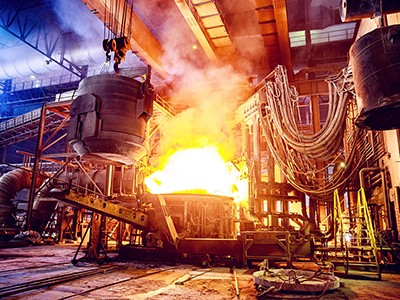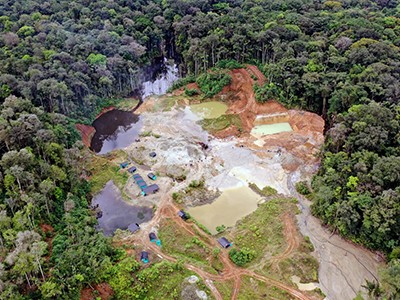It was a meeting that shocked the world. On 28 February, Ukrainian President Volodymyr Zelenskyy met with US President Donald Trump in the Oval Office. Trump’s aim was “getting some of the rare earth” as payment for US weapons after Russia’s invasion of Ukraine in 2022. Negotiations broke down at the meeting, but later, on 30 April, Trump landed his deal. And he has been seeking other deals since, including signing a joint agreement with Australia on 21 October to secure critical-mineral and rare-earth supply chains.
Climate change is devastating mining of minerals needed to fight it
Access to minerals has long been an undercurrent of international relations, but rarely has it been so openly espoused, or so at odds with what the public thought those minerals were for. Once promoted as the minerals of the energy transition and digital transformations, Trump openly justifies critical minerals as the minerals of war. “We’re going to be… taking it, using it for all the things we do,” Trump said in February, “including … weapons and the military” (see go.nature.com/47by3cn).
Although minerals are at the centre of contemporary discussions on war, renewable energy and technology, they are also of immense relevance to human development, notably ending poverty in all its forms — the first priority of the UN Sustainable Development Goals (SDGs).
Here we trace the national-security origins of the term critical minerals and what this implies for global inequality. We then draw lessons from how other natural resources have been reframed to show why a human-centred approach is essential to meet humanity’s needs for these minerals.
Geopolitical origins
Critical minerals have long been a focus of military planning. As early as the First World War, the War Industries Board compiled a list of strategic and critical minerals that were crucial to US industry and in short supply1. In 1921, the US Army General Staff adopted its first official list distinguishing between minerals that were ‘strategic’ for defence and industry; those that were ‘critical’ owing to shortages; and those that were ‘essential’ even if they didn’t meet either criteria. In 1944, the US Army and Navy Munitions Board developed a combined definition of ‘strategic and critical minerals’ as “those materials required for essential uses in a war emergency…the procurement of which [is] sufficiently uncertain for any reason to require prior provision for the supply thereof”1.
Frequent changes to the lists, terminology and policy followed in the United States, but it was the 2010 ‘rare-earth crisis’ that triggered the contemporary interest by a wider array of countries.

Metals are key to the global economy — but three challenges threaten supply chains
On 7 September 2010, a Chinese fishing boat collided with two Japanese Coast Guard vessels off the Senkaku islands in the East China Sea. The arrest of the fishing-boat captain caused a diplomatic incident between the two nations. At around the same time, China halted exports of rare-earth elements (REEs), of which Japan was a major importer. This caused prices to skyrocket, revealing the economic vulnerability of countries when mineral supply chains are narrow.
Japan’s response, which was to invest in diversification, stockpiling, recycling and alternatives, became a blueprint for wider efforts. It spurred the development of critical-minerals strategies and lists by the European Union (2011), the United States (2018), Australia (2019), Canada (2021), the United Kingdom (2022), India, Indonesia, Japan and South Korea (2023), and South Africa and New Zealand (2025).
In 2022, many of these countries came together under the Minerals Security Partnership to coordinate efforts to improve supply security. These strategies and lists build on the US definition, refined over the past century: a critical mineral is a material that is essential to the economy or national security, has a supply chain vulnerable to disruption and is crucial for manufacturing a product.
Critical-mineral confusion
After the rare-earth crisis, and the 2015 Paris agreement, addressing climate change became a more urgent policy priority for various governments and international institutions, many of which began using the term critical minerals as though it meant the minerals of renewable energy. In truth, however, most critical minerals are not energy-transition minerals, and most energy-transition minerals are not critical minerals.
For instance, roughly 60% of the critical minerals on the EU, US and Australian lists have no energy-transition use case2. Indeed, the EU includes coking coal on its list. Conversely, critical minerals make up less than 2% of energy-transition mineral demand (by volume). Mineral ingredients of concrete, such as sand and cement, which are crucial for renewable energy infrastructure, constitute 70% of demand2.

Superpowers want to control critical mineral supplies — local communities need a stronger say
Even when volume is set aside, many minerals needed for the energy transition do not feature on critical mineral lists2. Copper, for example, is essential to renewable energy but is not typically considered critical, given its diverse supply and limited vulnerability to disruption. There are exceptions, however, including South Korea, which includes it on its list.
In other words, critical minerals are defined not as minerals that are important, but as those that are in a state that is vulnerable to disruption — critical as in ‘the critical care unit of a hospital’, not critical as in ‘society can’t live without them’.
And although supply disruption is relevant, any attempt to plan for the energy transition should be concerned with all the minerals that are necessary, not just those with narrow supply chains. The mineral ingredients of concrete are important, yet they are absent from the discussion, or indeed any planning, even though they face huge affordability, sustainability and environmental issues3.
Critical to whom?
The realization that the term critical mineral is not a synonym for energy-transition mineral has led some institutions to seek alternatives.
The United Nations Environment Programme and the Extractive Industries Transparency Initiative both use the term ‘transition mineral’. Chemists will immediately pick up the awkwardness of using this term because ‘transition metals’ are already known as a group of twelve elements in the d-block of the periodic table.

Quarry workers cut slabs of limestone in Egypt.Credit: Ahmed Gamal/NurPhoto via Getty
Similarly, the UN Secretary-General’s Panel on Critical Energy Transition Minerals used the term ‘critical energy transition minerals’ in its 2024 report4. Its remit was confined to those minerals necessary for constructing, producing, distributing and storing renewable energy and associated infrastructure.
The African Union, too, avoided the term critical minerals in its Green Minerals Strategy, partly because of a desire to focus only on energy-transition minerals, but also because the term begs the question, critical to whom?
Across African countries, it is common to hear the phrase, ‘critical minerals are not critical to us’. And they have a point. Most nations that have critical-mineral lists are industrialized and looking to shore up mineral imports. There are exceptions, including Australia, Canada and South Africa, who are mineral exporters. Their lists include minerals deemed critical not for themselves, but for import by their trading partners.
The top exporters of raw critical minerals also have something in common: they lack a large industrial base. In the context of a mainly one-way flow of minerals from low- and middle-income countries (LMICs) to high-income nations, it is understandable that exporters might think that the global critical-minerals agenda is not focused on their own needs. Although they might — or might not — be able to secure a part of the processing value chain or revenue and employment from mineral extraction, ultimately the minerals are used elsewhere.
The human turn
A mineral-security agenda that is defined solely by the national-security priorities of industrialized nations is prone to geopolitical competition and neglect of the broader needs of humanity.
The world has been here before — the concept of energy security was popularized as a national-security response to the 1970s oil crisis. Similarly, the concept of food security prioritized national availability. Only after the Nobel-prizewinning work of economist Amartya Sen in the early 1980s and 1990s identified that it is not broader disruptions to supply that cause famine, but the inaccessibility of food for those individuals who need it5, were these concepts reframed from a human-centred perspective.

Impacts for half of the world’s mining areas are undocumented
Sen would go on to help publish the first UN Human Development report with Pakistani economist Mahbub ul Haq in 1990, and they and others would define the phrase human security, in the 1994 version of the report6. Human security is ‘freedom from fear’ and ‘freedom from want’. It puts people at the centre of analysis — it imagines that the security of all people is much more than their physical safety, and it is intended to complement, not replace national security.
The human-centred versions of food security, energy security and water security, which emphasize accessibility to all people, are now central ideas in the SDGs. Yet, that’s not the case for minerals.
It is hard to believe it, but the 15,000-word SDG agenda Transforming Our World makes no reference to minerals — the only natural resource that is missing. Not only do minerals lack a relevant goal, but the resource, occupations, sector and activities do not appear in the agenda7. The omission of minerals from the SDGs has led overseas development assistance to the mineral sector to plummet to just under US$600 million of the $239 billion spent by 2021, representing 0.2%, among the lowest by sector.

